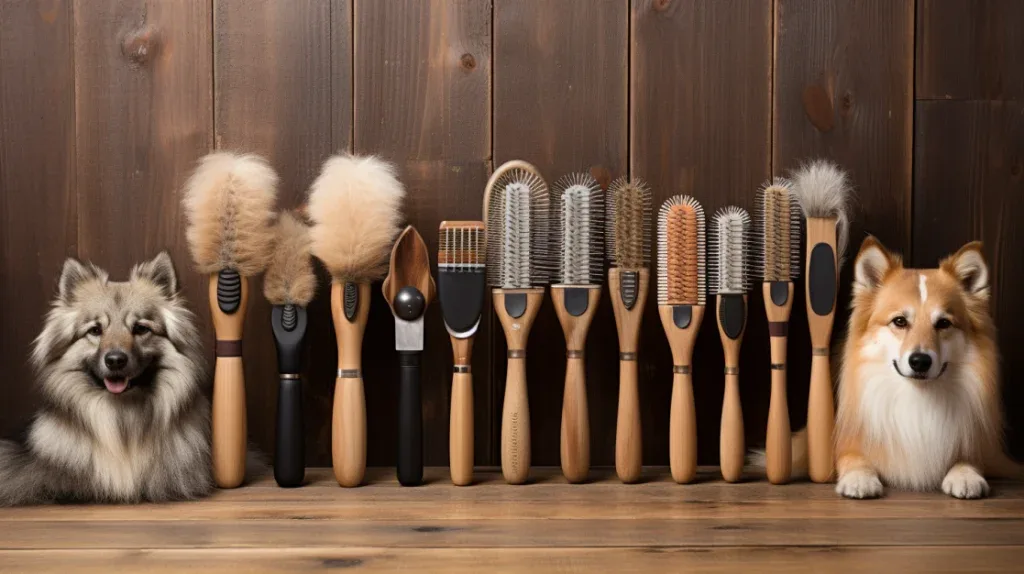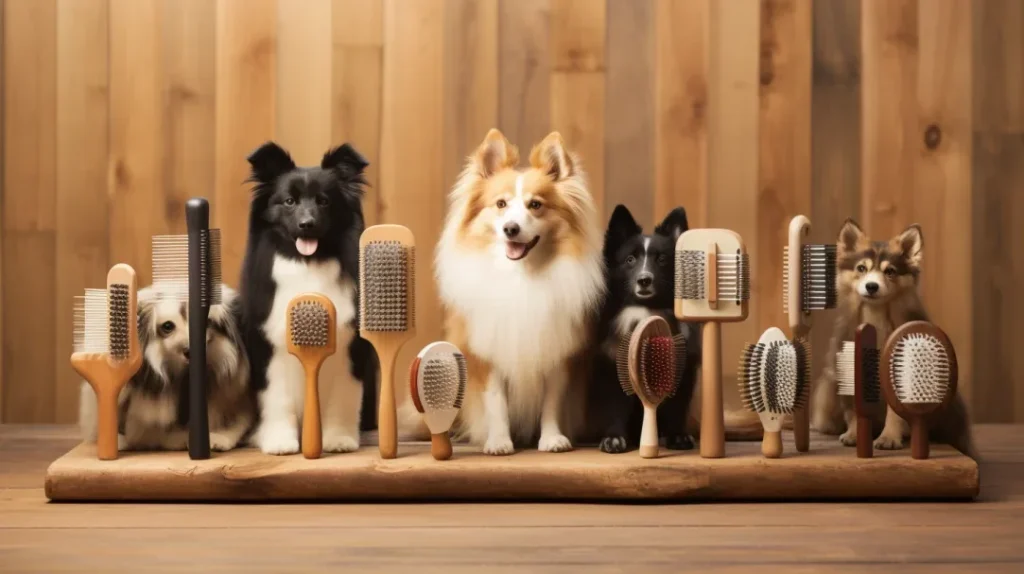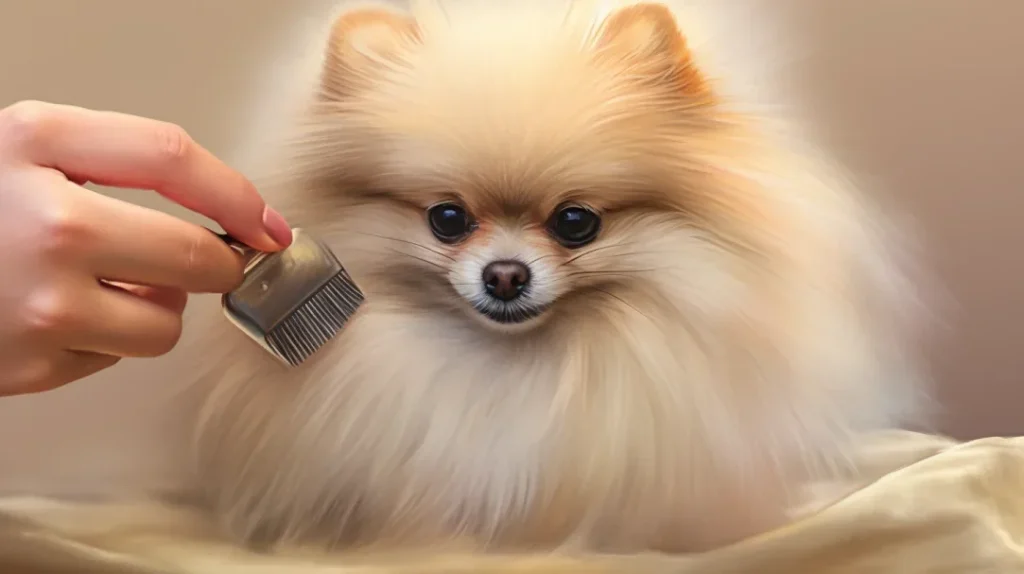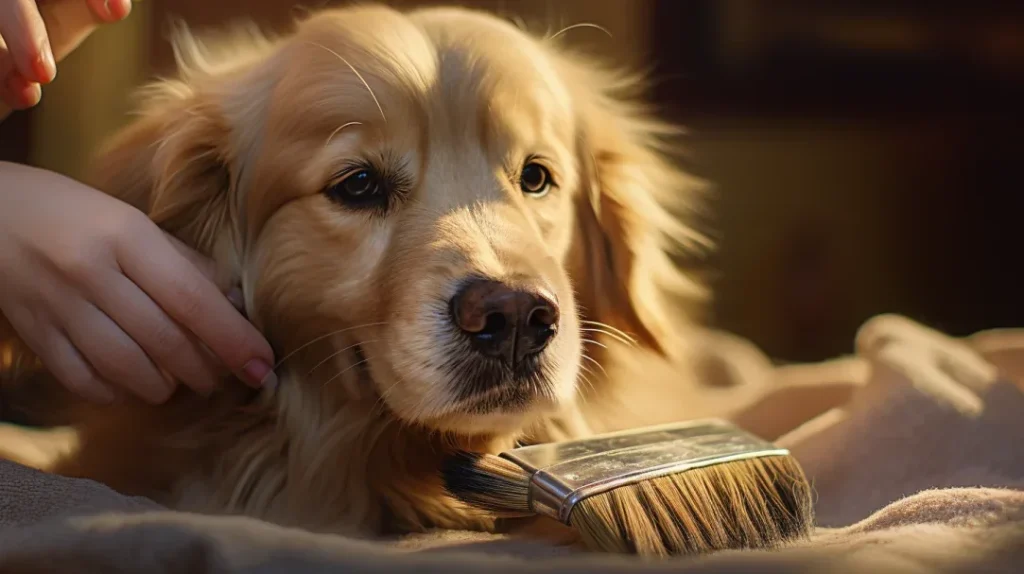Are you tired of battling tangles and shedding? Look no further! Our ultimate guide to dog grooming brush is here to save the day.
From slickers that tackle unruly fur to bristles that give your pup a polished finish, we have all the tools you need for a well-groomed pooch.
Follow our step-by-step guide and discover tips and tricks for effective brushing.
Say goodbye to furballs and hello to a beautifully groomed companion!
Key Takeaways
- Different types of dog grooming brushes serve other purposes
- Understanding your dog’s coat type and grooming needs is crucial in choosing the right brush
- Regular brushing offers numerous benefits for your dog’s coat health
- Avoid common brushing mistakes and use the appropriate grooming tools for effective brushing
What Is Dog Grooming?
Dog grooming refers to the various practices and techniques to keep a dog’s coat healthy and clean. Regular grooming is essential for all dogs, regardless of their coat type, to prevent matting and protect their skin from irritations and infections.
One important aspect of grooming is frequent brushing. There are different types of brushes available for different coat types. Slicker brushes, for example, are great for removing loose hair and keeping the coat tangle-free. Pin brushes are ideal for dogs with longer coats as they can reach through the topcoat to the undercoat.
Bristle brushes are commonly used on smooth-coated dogs to remove debris and distribute natural oils. For dogs with curly coats, a rubber or curry brush can do wonders. It helps to remove dead hair and massage the skin simultaneously.
Regular brushing helps remove excess hair and promotes blood circulation, resulting in a healthier coat. Choosing the right brush and grooming your dog according to their needs and hair type is essential.
Remember, grooming sessions should be a positive experience for your dog, so always use gentle strokes and provide treats or praise for good behavior.
A Guide to Dog Grooming Brush and Tools
Grooming is essential to caring for your dog, and using the right brushes and tools can make a big difference. Here is a concise guide to help you choose the right grooming brushes and tools for your furry friend.
1. Slicker brushes: Perfect for removing loose hair and tangles, especially for dogs with longer coats.
2. Pin brushes: Ideal for reaching through the topcoat to the undercoat, making them great for dogs with longer coats.
3. Bristle brushes: Commonly used on smooth-coated dogs, these brushes remove debris and distribute natural oils.
4. Rubber or curry brushes: Great for dogs with curly coats, as they remove dead hair and massage the skin simultaneously.
Regular brushing helps remove excess hair and promotes blood circulation, resulting in healthier coats. Remember to choose the right brush for your dog’s needs and hair type.
Aside from brushes, other essential tools include flea combs, de-shedding tools, undercoat rakes, and wide-toothed combs. Nail clippers are also crucial for keeping your dog’s nails trimmed.
By selecting the appropriate brushes and tools and establishing a regular grooming routine, you’ll help your dog look and feel their best.
Different Types of Dog Grooming Brushes
Various types of dog grooming brushes are available, each serving a different purpose. Understanding the needs of your dog’s coat is essential to find the right brush. Other breeds have specific coat requirements that must be met through regular brushing.
For example, dogs with long silky coats, like Golden Retrievers or Afghan Hounds, need brushes with longer bristles to prevent matting and tangles. On the other hand, short-haired dog breeds such as Boxers or Beagles would benefit from slicker brushes that remove loose hair and promote a healthy shine.
Regular brushing offers numerous benefits, like reducing shedding, preventing skin issues, and improving blood circulation. Now that you know about the different types of brushes and their advantages, let’s move on to how you can choose the right brush for your furry friend.
Slicker Brush
Slicker brushes are an essential grooming tool for dogs with longer coats. These brushes are designed to remove loose hair and tangles, keeping your dog’s coat tidy and free from mats.
The bristles of a slicker brush are fine and close together, allowing them to reach deep into the coat and comfortably remove any trapped hair. They are also gentle on your dog’s skin, preventing discomfort or irritation during grooming sessions.
Using a slicker brush regularly is a great way to maintain your dog’s coat health and appearance. By brushing through the fur, you’ll remove excess hair and distribute the natural oils, leaving the coat looking shiny and healthy.
Because slicker brushes effectively remove loose hair, they are instrumental during shedding seasons. Regular brushing with a slicker brush can help to minimize shedding and keep your home cleaner.
When choosing a slicker brush, look for a comfortable handle and sturdy bristles that won’t easily bend or break. Consider your dog’s coat type and size to ensure you select the right brush for their needs.
Overall, a slicker brush should be a staple in your grooming tool collection if you have a dog with longer hair. It will make grooming sessions more comfortable for your dog and keep their coat looking beautifully maintained.
Benefits of Using a Slicker Brush
Using a slicker brush for dog grooming offers several benefits. Firstly, it removes loose hair, tangles, and mats from the coat, preventing them from becoming more problematic. Regular brushing with a slicker brush helps to maintain healthy skin by distributing natural oils and promoting a shiny appearance.
Slicker brushes suit all coat types, making them versatile grooming tools. They are handy for breeds with double coats or long hair, as they can efficiently remove dead hair and keep the skin healthy.
Additionally, when used correctly, slicker brushes are gentle on the dog’s skin. They have fine wire bristles that reach through the topcoat without causing discomfort. This makes them suitable for dogs with sensitive skin or fine, delicate coats.
Using a slicker brush also reduces shedding around the home, effectively removing loose and excess hair. This can be especially beneficial for dog owners who have allergies or prefer a cleaner environment.
In conclusion, incorporating a slicker brush into your dog grooming routine can help keep your dog’s coat in top condition, minimize shedding, and promote skin health.
Pin Brush
Pin brushes are another dog grooming brush ideal for dogs with longer coats or curly hair. They have long, rounded pins that can easily penetrate through the dense hair without causing any discomfort to the dog.
Pin brushes are great for removing tangles and mats from the coat, as the pins can work through the hair without pulling or tugging. This makes them an excellent choice for breeds with thick, heavy coats or dogs requiring regular grooming to prevent matting.
In addition to detangling, pin brushes are also great for distributing natural oils throughout the coat, promoting a healthy and shiny appearance. Regular brushing with a pin brush can help prevent knots and keep the skin smooth and manageable.
It’s important to note that pin brushes may not be suitable for dogs with short hair or sensitive skin, as the pins may be too harsh or irritating. Always choose a meeting ideal for your dog’s specific coat type, and consult with a professional groomer if you have any concerns.
Benefits of Using a Pin Brush
Using a Pin Brush for dog grooming has numerous benefits. First and foremost, it is ideal for dogs with medium to long coats, as the rounded pins prevent scratching or irritating the skin. This brush is versatile and can be used on various coat types.
One of the key benefits is its effectiveness in removing tangles, mats, and loose hair. The angled pins penetrate deep into the coat, ensuring thorough grooming. Regular brushing with a Pin Brush helps maintain clean and healthy skin by removing dirt, debris, and dead hair.
A Pin Brush stimulates the skin and promotes blood circulation, contributing to a healthier coat. Dogs with longer hair must prevent matting and keep their coat in optimal condition.
Moreover, Pin Brushes are available in different variations, such as the standard pin brush, paddle pin brush, and slicker pin brush, offering options to cater to various grooming needs. The soft, gentle pins suit dogs with sensitive or easily irritated skin.
Utilizing a Pin Brush as part of your grooming routine keeps your dog looking its best and promotes a bond between you and your furry friend. Regular brushing sessions are essential for overall dog health and cleanliness.
Bristle Brushes
Bristle brushes are another popular option for dog grooming. These brushes have dense, stiff bristles that are perfect for removing loose hair and dirt from your dog’s coat. They are especially effective for dogs with short or smooth coats.
Regular brushing with a bristle brush helps to distribute natural oils throughout your dog’s coat, keeping it healthy and shiny. It also stimulates the skin, promoting blood circulation and overall skin health.
Bristle brushes come in various sizes and types, including single-sided and double-sided brushes. The single-sided meetings are great for general grooming, while the double-sided brushes have coarse and fine bristles, allowing for more precise grooming.
When choosing a bristle brush, choose one with a comfortable handle and sturdy construction. Look for bristles made from durable materials like nylon or natural fibers.
In conclusion, bristle brushes are a versatile and effective tool for maintaining your dog’s coat by removing loose hair, distributing natural oils, and promoting overall skin health. They are especially beneficial for dogs with short or smooth coats, making them an essential grooming tool for every pet owner.
Benefits of Using a Bristle Brush
First, bristle brushes are excellent for removing loose hair from your dog’s coat. The coarse bristles penetrate deep into the fur, helping to dislodge any dead hair or tangles. This is especially useful for dogs with longer or thicker coats that often shed heavily.
Additionally, bristle brushes are great for distributing natural oils throughout your dog’s coat. These oils help keep the skin healthy and shiny while preventing it from drying out or becoming brittle.
Furthermore, bristle brushes provide a gentle grooming experience for dogs with sensitive skin. The soft bristles or rounded tips on some meetings prevent irritation and discomfort while still effectively grooming the coat.
Lastly, some bristle brushes have features like ergonomic handles or anti-static properties. This makes brushing more comfortable for you and your dog while preventing hair from sticking to the meeting.
Using a bristle brush as part of your regular grooming routine is a great way to keep your dog’s coat in top shape and promote a healthy and comfortable grooming experience.
Rubber Brushes & Curry Combs

Rubber brushes and curry combs are essential grooming tools for dogs of all coat types. These brushes are made with gentle rubber bristles that effectively remove loose hair and massage the skin.
Rubber brushes are handy for dogs with shorter coats. The bristles grab onto loose hair, making it easy to remove and reducing shedding around your home. They also stimulate the skin, promoting blood circulation and ensuring a healthy coat.
On the other hand, Curry combs have a handheld design that allows for easy grip and control. The rubber bristles help to remove dirt, debris, and excess hair from your dog’s coat. This brush is excellent for dogs with longer or thicker coats, as it can effectively reach through the fur to remove tangles and matted hair.
Rubber brushes and curry combs are gentle on the skin, making them suitable for dogs with sensitive skin or those who don’t enjoy brushing. They can be used during bath time to help distribute shampoo and promote a thorough cleaning.
In conclusion, rubber brushes and curry combs are versatile grooming tools that help keep your dog’s coat clean, healthy, and loose hair-free. Consider adding these brushes to your grooming routine for best results.
How to Choose the Right Brush for Your Dog

When selecting a brush for your pup, it’s essential to consider their type of coat and grooming needs. Understanding your dog’s coat type is crucial in choosing the right brush to effectively remove tangles and mats while keeping their fur healthy and shiny.
Factors to consider when choosing a dog grooming brush include:
- Coat Length: Long-haired dogs breeds require brushes with longer bristles or wire pins to penetrate through their thick fur.
- Coat Texture: Dogs with wiry coats need stiff bristles or slicker brushes to maintain their unique texture.
- Sensitivity: For dogs with sensitive skin, opt for brushes with soft bristles or rubberized tips to prevent irritation.
By considering these factors, you can ensure that you select the perfect brush for your furry friend.
Now that you understand how to choose the right brush let’s move on to a step-by-step guide to brushing your dog’s coat.
Step-by-Step Guide to Brushing Your Dog’s Coat

To begin brushing your dog’s coat, gently run the brush through its fur in short strokes, focusing on one section at a time. This will help remove tangles or mats without causing discomfort to your furry friend. However, it’s essential to be aware of common mistakes that can occur during the grooming process. Avoid brushing too aggressively, as this can cause skin irritation and pain for your dog.
Use the appropriate brush for your dog’s coat type to ensure effective grooming. The frequency of brushing depends on your dog’s breed and coat length. For example, dogs with longer hair may require daily brushing, while shorter-haired breeds may only need it once a week. By following these guidelines and avoiding common mistakes, you can keep your dog’s coat healthy and looking its best.
| Common Mistakes | How Often Should You Brush? |
|---|---|
| Brushing too aggressively | Daily for long-haired breeds |
| Using the wrong brush | Once a week for short-haired breeds |
| Neglecting certain areas like underarms and ears | Varies based on breed and coat length |
| Not checking for ticks or fleas while brushing | Regularly inspect during each grooming session |
Tips and Tricks for Effective Brushing

Using the right grooming tools, such as de-shedding combs or slicker brushes, can help remove loose hair and prevent matting. When brushing your dog’s coat, it’s essential to avoid common mistakes that can lead to tangles and mats.
Here are some tips and tricks for effective brushing:
- Start with a gentle approach: Use a soft brush or comb to work through any tangles or mats gently.
- Use short strokes: Brush in small sections, using short strokes rather than long ones. This will allow you to focus on removing loose hair without causing discomfort.
- Be patient: Take your time when brushing your dog’s coat. Rushing through the process can result in missed tangles or mats.
Maintaining and Cleaning Your Dog Grooming Brushes

Ensure you regularly clean and maintain your grooming brushes to keep them in good condition. Cleaning techniques may vary depending on the type of brush you have. Here are some recommended cleaning products for different types of grooming brushes:
| Brush Type | Recommended Cleaning Products |
|---|---|
| Slicker Brush | Pet-safe brush cleaner or mild soap and water |
| Bristle Brush | Soft bristle brush cleaner or baby shampoo |
| Undercoat Rake | Remove loose hair with a comb, then wash with warm soapy water |
| Deshedding Tool | Use a deshedding tool cleaner or wipe with a damp cloth |
Regularly removing hair and debris from your brushes will help prevent matting and prolong their lifespan. After each use, remove any hair trapped in the bristles using a comb or your fingers. Then, follow the recommended cleaning technique for your specific brush type. Caring for your grooming brushes ensures they remain effective in keeping your dog’s coat healthy and beautiful.
Frequently Asked Questions
What is the best dog grooming brush?
The best dog grooming brush depends on your dog’s coat type. Slicker brushes are excellent for removing tangles and mats, while bristle brushes work well for short-haired breeds. For shedding, consider a de-shedding tool like a Furminator.
How does a dog grooming vacuum brushwork?
A dog grooming vacuum brush typically attaches to a vacuum cleaner and sucks up loose fur as you brush your dog. It helps reduce shedding and keeps your home cleaner.
What is a natural bristle dog brush?
A natural bristle dog brush typically has bristles made from raw materials like boar hair. It’s gentle and suitable for dogs with short or fine coats.
How do bristles work in dog grooming?
Bristles in dog grooming brushes help remove loose hair, dirt, and debris from a dog’s coat. They can also stimulate the skin and distribute natural oils for a healthier coat.
How do I choose the right dog grooming brush?
To choose the right dog grooming brush, consider your dog’s coat type and needs. Consult with a professional groomer or veterinarian for specific recommendations.
What is the purpose of a de-shedding tool for dogs?
A dog de-shedding tool is designed to remove loose, dead hair from the undercoat, reducing shedding and preventing mats and tangles.
How can I find the right dog brush for my pet?
To find the right dog brush for your pet, consider their coat type, length, and grooming needs. Consult with a veterinarian or professional groomer for guidance if you need clarification.
Are there brushes with both pins and bristles for dog grooming?
Yes, there are dog grooming brushes that combine both pins and bristles. These versatile brushes are helpful for various coat types and grooming needs.
What are the benefits of using a rubber curry brush for dog grooming?
A rubber curry brush for dog grooming is great for massaging and stimulating a dog’s skin, loosening dirt, and removing loose hair. It’s also easy to clean and maintain.
Can you recommend a specific dog brush for a particular coat type?
The best dog brush for a specific coat type varies, but slicker brushes are often recommended for long-haired breeds, while bristle brushes work well for short-haired breeds. Deshedding tools like Furminator are excellent for reducing shedding in double-coated species.
Conclusion
Congratulations on making it to the end of our ultimate guide to dog grooming brushes! With this newfound knowledge, you can tackle your furry friend’s coat with confidence and finesse.
Choosing the right brush is vital, so don’t be afraid to experiment and find what works best for your pup. With a bit of practice and some handy tips and tricks, you’ll soon become a master groomer.
So grab that brush, embrace your inner stylist, and get ready to transform your dog into the most glamorous pup on the block!
Happy grooming!
Quick Paw Note: While we’re passionate about providing helpful pet nutrition content, it’s essential to remember that this info isn’t a substitute for professional veterinary advice. Always consult your vet for your pup’s specific dietary needs. We strive for accuracy, but paw-lease note that we can’t guarantee the complete reliability of all content. Stay pawsome! 🐾




